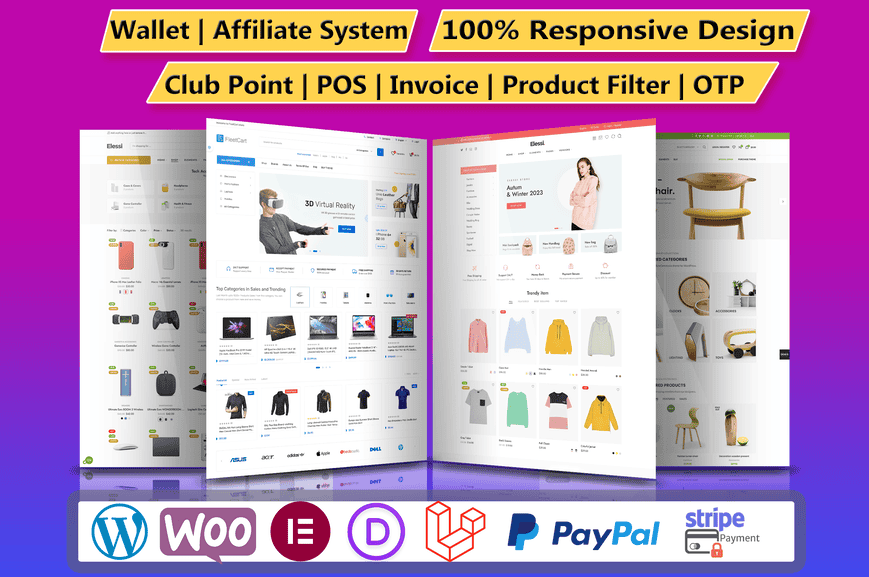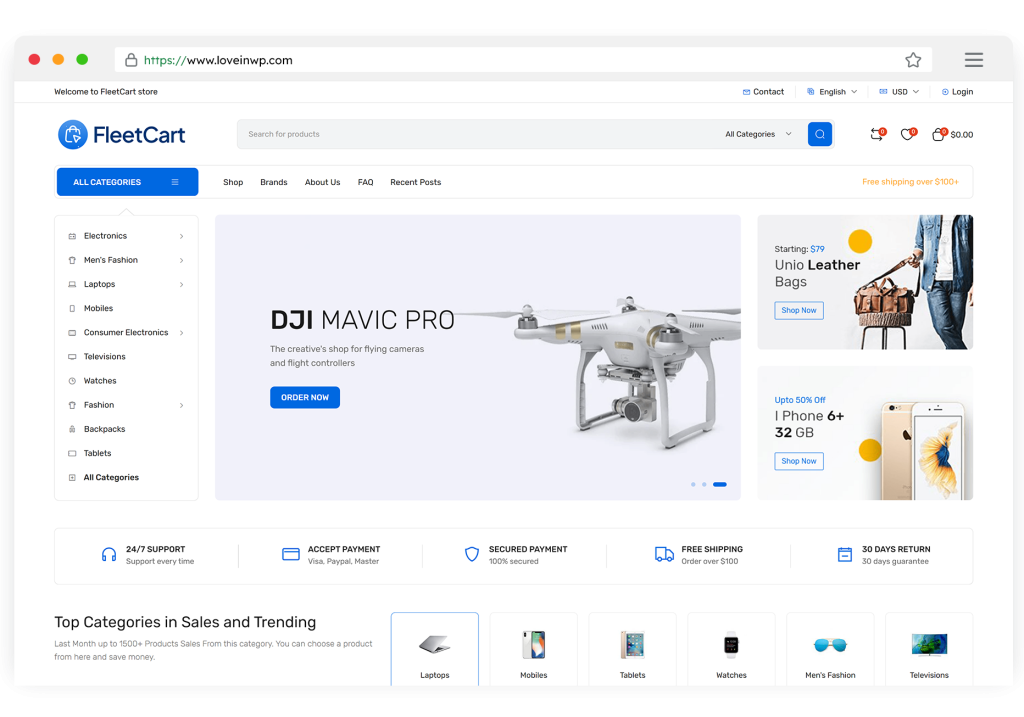The rise of e-commerce has revolutionized the way we shop. Gone are the days of limited selection and geographical constraints. Today, consumers can browse a vast array of products from the comfort of their homes, with purchases delivered directly to their doorsteps. This shift has opened a door of opportunity for aspiring entrepreneurs to launch their own e-commerce businesses.

Here at loveinwp, we understand the power of e-commerce and are passionate about helping businesses thrive online. This comprehensive guide will equip you with the knowledge and steps necessary to navigate the exciting journey of starting your own e-commerce business. From finding your niche to launching your online store and beyond, we’ll cover everything you need to know.
1. Unearthing Your Niche: The Seed of Your Success
The foundation of any thriving e-commerce business is a well-defined niche. This niche represents your area of focus, a specific market segment within a broader industry. Choosing a niche you’re passionate about and knowledgeable in allows you to:
- Connect with Your Audience: Your passion for your chosen niche will translate into engaging product descriptions, insightful blog posts, and a genuine desire to help your customers.
- Become an Authority: By focusing on a specific niche, you can establish yourself as a trusted authority within that market.
- Target Your Marketing Efforts: A defined niche allows you to tailor your marketing strategies to reach the right audience, maximizing your return on investment (ROI).
Here are some key factors to consider when selecting your niche:
- Passion and Knowledge: Are you genuinely enthusiastic about a particular product category or industry? Your passion will fuel your business decisions and keep you motivated during the inevitable challenges.
- Profitability: While pursuing your passion is important, consider the market potential of your chosen niche. Is there sufficient demand for the products or services you plan to offer? Research your target market and competition to ensure profitability.
- Competition: Analyze the level of competition within your chosen niche. Excessive competition can make it difficult to stand out. However, a healthy level of competition indicates a viable market. Consider targeting sub-niches within a broader market to find your sweet spot.
2. Crafting Your Business Blueprint: Planning for Success
Once you’ve identified your niche, it’s time to develop a comprehensive business plan. This plan will serve as your roadmap to success, outlining your goals, strategies, and financial projections. Here are some elements to consider when crafting your e-commerce business plan:
- Executive Summary: Briefly introduce your business, its mission, and core values.
- Market Analysis: Delve into the market research you conducted on your chosen niche, including target audience demographics, market trends, and competitor analysis.
- Business Model: Outline how you plan to generate revenue. Will you be selling your own products, dropshipping, or offering a combination of both? Define your pricing strategy and margin expectations.
- Marketing Strategy: Describe how you plan to reach your target audience. Explore various marketing channels like social media marketing, content marketing, search engine optimization (SEO), and paid advertising.
- Operational Plan: Detail your plan for sourcing products, managing inventory, fulfilling orders, and handling customer service inquiries.
- Financial Projections: Include financial forecasts, like projected sales, expenses, and profitability timelines. This section will be particularly helpful when seeking funding or securing partnerships.
3. Finding Your Perfect Home: Choosing the Right E-commerce Platform
Your e-commerce platform is the digital storefront where your products will reside. It’s where customers will browse your offerings, make purchases, and manage their accounts. Here are some key factors to consider when choosing the right e-commerce platform:
- Features and Functionality: Ensure the platform offers the features you need to manage your business effectively. This includes product management tools, shopping cart functionality, secure payment processing options, and built-in marketing tools (e.g., email marketing, SEO optimization features).
- Scalability: Choose a platform that can scale with your business growth. As your product offering and customer base expand, your platform should be able to handle the increased traffic and data demands.
- Ease of Use: Consider your technical expertise and comfort level. Some platforms offer user-friendly drag-and-drop interfaces, while others require more technical knowledge.
- Pricing Structure: E-commerce platforms have different pricing models, including monthly subscription fees, transaction fees, or a combination of both. Compare pricing structures and choose a platform that aligns with your budget and business needs.
Here are some of the most popular e-commerce platforms:
- WooCommerce (WordPress plugin): A free and open-source platform offering high customization capabilities. Requires some technical knowledge to set up and manage but offers greater flexibility for web development-savvy entrepreneurs.
- Shopify: A user-friendly platform popular for its extensive app store offering a wide range of functionalities and integrations. Ideal for beginners and established businesses alike.
- BigCommerce: A robust platform designed for larger businesses with a focus on scalability and advanced features.
- Squarespace: An all-in-one solution ideal for businesses seeking a user-friendly platform with built-in website creation and e-commerce functionalities.
4. Building Your Digital Haven: Designing a User-Friendly Website
Your e-commerce website is the cornerstone of your online presence. It’s crucial to create a website that is visually appealing, user-friendly, and optimized for conversions (turning website visitors into paying customers). Here are some design elements to prioritize:
- Clean and Intuitive Design: Prioritize a clean, clutter-free website design with a clear layout and intuitive navigation. Visitors should be able to easily find the products they’re looking for and complete the checkout process without encountering any difficulties.
- High-Quality Product Images: Invest in high-quality product images that showcase your offerings in detail. Include multiple product images from different angles and consider incorporating 360-degree product views if possible.
- Compelling Product Descriptions: Craft informative and engaging product descriptions that highlight the features and benefits of your offerings. Use clear and concise language while incorporating relevant keywords for search engine optimization (SEO).
- Customer Reviews and Testimonials: Showcase customer reviews and testimonials to build trust and social proof. Positive reviews can significantly influence purchasing decisions.
- Mobile-Friendly Design: Ensure your website is responsive and adapts seamlessly to various screen sizes, including desktops, tablets, and smartphones. A significant portion of online shopping occurs on mobile devices, so optimizing your website for mobile responsiveness is crucial.
Here’s where loveinwp comes in! Our team of experienced developers can help you create a beautiful, user-friendly e-commerce website that converts visitors into customers. We offer various e-commerce web development solutions, including:
- Theme Selection and Customization: Assisting you in choosing a pre-built e-commerce theme or customizing an existing theme to match your brand identity.
- Plugin Integration: Integrating essential e-commerce plugins for functionalities like product management, payment processing, shipping options, and marketing automation.
- SEO Optimization: Optimizing your website content and structure for search engines to improve organic traffic and online visibility.
- Ongoing Support: Providing ongoing support and maintenance to ensure your website functions smoothly and remains secure.
5. Gearing Up for Sales: Sourcing Products and Inventory Management
Now that your website is up and running, it’s time to focus on your product offerings. Here are some key considerations for sourcing products and managing your inventory:
- Sourcing Strategies: There are several ways to source products for your e-commerce business. You can manufacture your own products, dropship from a supplier, or purchase wholesale from distributors. Research each option and choose the model that best aligns with your business model and resources.
- Inventory Management: Developing a sound inventory management system is crucial to ensure you have enough stock to meet customer demand without overstocking and incurring unnecessary storage costs. Inventory management software can help you track stock levels, set reorder points, and optimize your inventory flow.
- Quality Control: Ensure you prioritize quality control, especially if you’re working with suppliers or manufacturers. Perform thorough quality checks before listing products on your website to maintain customer satisfaction.
6. The Art of Attraction: Crafting a Winning Marketing Strategy
In today’s competitive online landscape, simply having a website isn’t enough. You need a comprehensive marketing strategy to reach your target audience and drive traffic to your online store. Here are some effective marketing strategies to consider:
- Search Engine Optimization (SEO): Implement SEO best practices to improve your website’s ranking in search engine results pages (SERPs). This will increase organic traffic and make your store more visible to potential customers searching for products like yours.
- Content Marketing: Create valuable and informative content related to your niche. This can include blog posts, product reviews, how-to guides, and infographics. Publishing high-quality content establishes your brand as an authority, attracts organic traffic, and fosters customer engagement.
- Social Media Marketing (continued): Utilize social media advertising options to target specific demographics and interests, further expanding your reach and driving targeted traffic to your website.
- Email Marketing: Build an email list of subscribers interested in your products and niche. Utilize email marketing to nurture leads, share valuable content, announce new product launches, and run targeted promotions.
- Influencer Marketing: Partner with social media influencers within your niche to promote your products to their audience. Influencer marketing can be a powerful way to reach a wider audience and leverage the credibility of established figures within your niche.
- Paid Advertising: Consider incorporating paid advertising strategies like Google Ads, Facebook Ads, or native advertising platforms into your marketing mix. Paid advertising allows you to target highly specific demographics and interests, driving high-quality traffic to your website.
7. Building Trust and Transparency: Customer Service is Key
Exceptional customer service is paramount in the e-commerce world. Positive customer experiences not only lead to repeat business but also generate positive word-of-mouth marketing that can significantly impact your brand reputation. Here are some ways to prioritize customer service:
- Provide Clear and Consistent Communication: Ensure all product information, shipping policies, and return procedures are clearly outlined on your website. Offer multiple channels for customer communication, such as email, live chat, and phone support.
- Respond Promptly to Inquiries: Strive to respond to customer inquiries and concerns promptly and professionally. A timely and helpful response demonstrates that you value your customers and are committed to their satisfaction.
- Handle Returns and Refunds Efficiently: Develop a clear and customer-friendly return and refund policy. Process returns and refunds promptly to avoid customer frustration.
- Go the Extra Mile: Look for opportunities to exceed customer expectations. A personalized touch, such as a handwritten thank you note with a first order, can create a lasting positive impression.
8. The Power of Data: Measuring Your Success
Tracking your e-commerce business performance is crucial for monitoring progress and identifying areas for improvement. Here are some key metrics to track:
- Website Traffic: Analyze website traffic data to understand how many visitors are coming to your website and where they are coming from.
- Conversion Rate: Track your conversion rate, which refers to the percentage of website visitors who complete a desired action, such as making a purchase.
- Customer Acquisition Cost (CAC): Measure the cost of acquiring new customers through your marketing efforts.
- Average Order Value (AOV): Track your average order value, which is the average amount spent per order.
- Customer Lifetime Value (CLTV): Calculate the customer lifetime value, which represents the total revenue a customer is expected to generate over their relationship with your business.
By monitoring these metrics and analyzing the data collected, you can gain valuable insights into your e-commerce business performance. Utilize this data to refine your marketing strategies, optimize your product offerings, and make data-driven decisions that fuel your business growth.
Conclusion: Launching Your E-commerce Journey with loveinwp
The world of e-commerce is dynamic and ever-evolving. However, with careful planning, a well-defined strategy, and the right tools, you can navigate this exciting landscape and build a thriving online business.
At loveinwp, we are passionate about empowering entrepreneurs to achieve their e-commerce dreams. Whether you’re just starting or looking to scale your existing business, we offer a comprehensive suite of services to help you succeed, including:
- E-commerce Website Development: Our team of experienced developers can create a beautiful, user-friendly, and conversion-optimized e-commerce website tailored to your specific needs and brand identity.
- Search Engine Optimization (SEO): We can help you optimize your website content and structure to improve your search engine ranking and drive organic traffic.
- Marketing Strategy Development: Our team can assist you in crafting a comprehensive marketing strategy that leverages various channels to reach your target audience and achieve your business goals.
- Ongoing Support and Maintenance: We offer ongoing support and maintenance services to ensure your e-commerce website functions smoothly, remains secure, and adapts to evolving trends.
Partner with loveinwp today and embark on your e-commerce journey with confidence! Together, we can turn your e-commerce vision into a reality.





